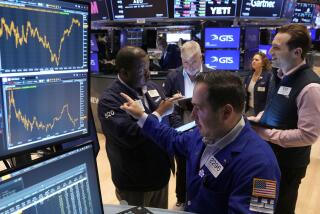Leading Banks Trim the Prime 0.25 Point to 9% : Home Loan Rates Drop as Investors Spurn Stocks for Security of Bonds
The nationâs biggest banks, including the major ones in California, cut their prime lending rate to 9% from 9.25% on Thursday, continuing the drop in interest rates that began after Mondayâs stock market crash.
The general rate decline has been highlighted by a dramatic drop in fixed-rate home loans, whose averages had soared beyond 12% last week but have since fallen nearly a full percentage point.
âThe drop has been absolutely astounding,â said Sigmund Anderman, chief executive of a mortgage rate survey firm in Santa Ana known as Compufund National Mortgage Network.
The latest prime rate drop was initiated by New Yorkâs Citibank, the nationâs largest commercial bank, and quickly followed by other major financial institutions, including Bank of America and Wells Fargo in San Francisco, Security Pacific National Bank and First Interstate in Los Angeles and Continential Illinois National Bank in Chicago.
The prime is a benchmark that banks use to set interest rates on corporate and consumer loans. Though mortgage rates are not tied directly to the prime, their movement generally mirrors whatâs happening to the prime.
Money Floods Banks
The prime has been generally headed higher since March after it had bottomed out at 7.5%. Two New York banks--Chemical and Marine Midland--raised the prime a half percentage point to 9.75% just last week but later pulled back amid criticism of the move.
Allen Sinai, chief economist for the New York investment banking firm of Shearson Lehman Bros., predicted that the prime now may drop as much as another half percentage point in the next few weeks.
Banks are experiencing a âhuge reduction in loan demand and sharply lower costs of funds,â Sinai said, pointing out that âbanks have a flood of money coming in from the stock market, and that has cut their borrowing costs.â
Some bankers, though, didnât share Sinaiâs view.
âItâs a very fluid situation,â said Gary Schlossberg, vice president and senior economist for Wells Fargo. âIt should stay where it is, at least for now.â
Irwin Kellner, chief economist for Manufacturers Hanover in New York, was even less sanguine, saying he doesnât think the present cut is justified, given the current level of bank costs.
âThis drop is just a sign (that) the banks want to do their share to calm the market down,â Kellner maintained.
The Dow Jones industrial average fell a record 508 points Monday, rebounded a total of 289 points Tuesday and Wednesday before falling another 77 points Thursday.
The Federal Reserve, the nationâs central banker, has played a key role in the rate drops by keeping the banking system full of cash while the stock market crisis has been going on.
The Fed has pumped new money in the system every day this week through aggressive purchases of government securities. The Fed also has dramatized its concern by arranging the purchases an hour earlier than normal each day.
The fall in fixed-rate mortgages is directly related to the chaos in the stock market. Most fixed-rate mortgages are sold into the secondary market for packaging as mortgage-backed bonds, which are then sold to investors.
As investors have fled the stock market for the security of the bond market, bond values have gone up and corresponding yields plunged. The yield on the 30-year Treasury bond, for example, fell to 9.09% on Thursday from 9.45% on Wednesday.
âWeâre seeing a steep drop in the fixed-rate mortgages because of the sudden attractiveness of bonds as an alternative to stocks,â said John Tuccillo, chief economist of the National Assn. of Realtors.
Tuccillo believes that interest rates on fixed-payment mortgages should drop below 11% shortly, but adds that the drop probably will be temporary. Rates will move up again by the end of the year, he said.
âCompared to what has happened in the past and what will happen in the future, mortgage rates are going to be a bargain for awhile,â he said.
Though the rate drops are generally good news for consumers and borrowers, the flip side is savers are now receiving markedly lower yields on the money theyâre now putting into banks and savings and loans.
The average rate on a three-month bank certificate of deposit, for instance, has fallen to 7.85% from 8.75% in a matter of days, according to David Rolley, chief financial economist for the WEFA Group, an economic forecasting group in suburban Philadelphia.
Investors, seeking a safe haven for their money, have been pouring billions of dollars into the nationâs banking system and money-market mutual funds in the wake of the market turmoil. More than $5 billion recently has been pumped into nearly 300 money-market mutual funds followed by Donoghue Money Fund report, a Massachutsetts-based newsletter. Those funds now have $238 billion, another new record.
One important factor affecting interest rates is the nationâs growth rate. Preliminary third-quarter figures on the gross national product--which measures the output of the countryâs goods and services--is scheduled for release today.
More to Read
Sign up for Essential California
The most important California stories and recommendations in your inbox every morning.
You may occasionally receive promotional content from the Los Angeles Times.










